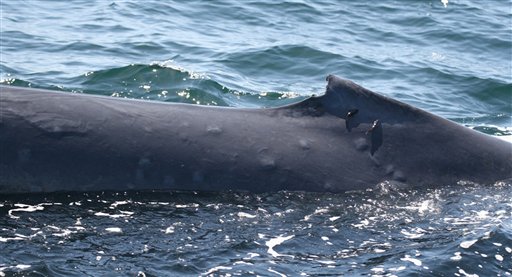Scientists say some whale species off the Mexican coast are showing signs of severe sunburn that may be caused by the damaged ozone layer’s decreased ability to block ultraviolet radiation.
The seagoing mammals would be particularly vulnerable to the sun damage in part because they need to spend extended periods of time on the ocean’s surface to breathe, socialize, and feed their young. Since they don’t have fur or feathers, that effectively means they sunbathe naked.
As Laura Martinez-Levasseur, the study’s lead author, put it: “Humans can put on clothes or sunglasses — whales can’t.”
Martinez-Levasseur, who works at Zoological Society of London, spent three years studying whales in the Gulf of California, the teeming body of water which separates Baja California from the Mexican mainland.
Photographs were taken of the whales to chart any visible damage, and small samples — taken with a crossbow-fired dart — were collected to examine the state of their skin cells.
Her study, published in the Proceedings of the Royal Society B, seemed to confirm suspicions first raised by one of her whale-watching colleagues: The beasts were showing lesions associated with sun damage, and many of their skin samples revealed patterns of dead cells associated with exposure to the powerful ultraviolet radiation emitted by the sun.
As with humans, the lighter-skinned whales seemed to have the most difficulty dealing with the sun. Blue whales had more severe skin damage than their darker-skinned counterparts, fin whales and sperm whales, even though the latter spend bigger chunks of time at the surface.
The study said the findings highlight the possible perils associated with the depletion of the ozone layer, which helps insulate the earth from ultraviolet rays.
That protective layer has been thinning for years under the influence of ozone-eating chemicals known as CFCs. While the emission of those chemicals has since largely been controlled, the extent to which the ozone is recovering is still under debate.
For whales, the potential danger from the sun’s rays are just one more environmental stress . All species tracked in this study are considered endangered or vulnerable by the International Union for Conservation of Nature. If it’s shown that the skin damage is leading to cancer, then “this could be a serious threat,” according to Simon Ingram, who teaches marine conservation at England’s University of Plymouth and wasn’t involved with the study.
So far, there were no indications of skin cancer among the whales studied, although Martinez-Levasseur noted that only tiny samples were taken of the massive animals.
She said one of her next projects will be to examine how well whales’ cells hold up under the increased ultraviolet radiation — and whether whales’ pigmentation darkens as a result of their time spent out in the sun.
In other words, she wants “to be able to see if they’re tanning.”
Scientists from Queen Mary, University of London, and the Cetacean Ecology Laboratory in Mexico also contributed to the study.
——
Online:
Proceedings of the Royal Society B: http://rspb.royalsocietypublishing.org/
Zoological Society of London: http://www.zsl.org/
Queen Mary, University of London: http://www.qmul.ac.uk/
Cetacean Ecology Laboratory (CICIMAR): http://www.cicimar.ipn.mx/oacis/

